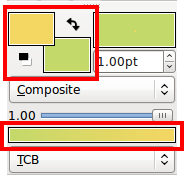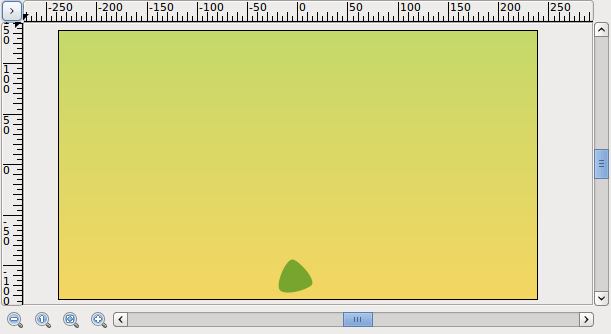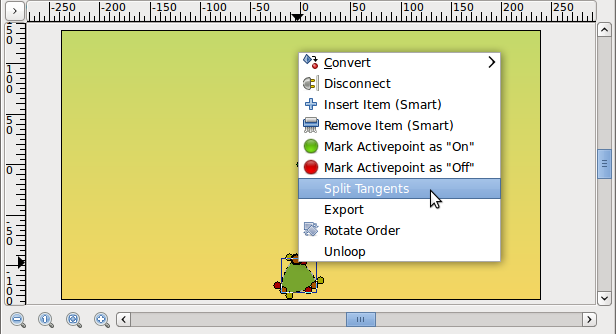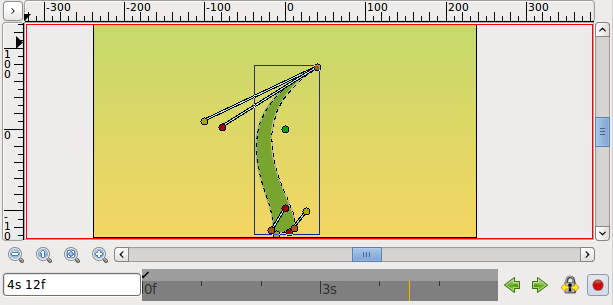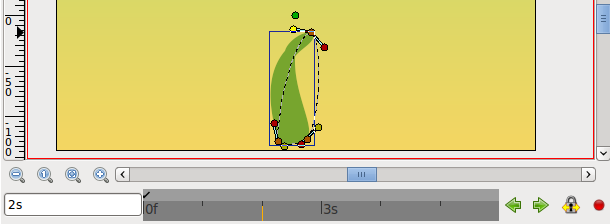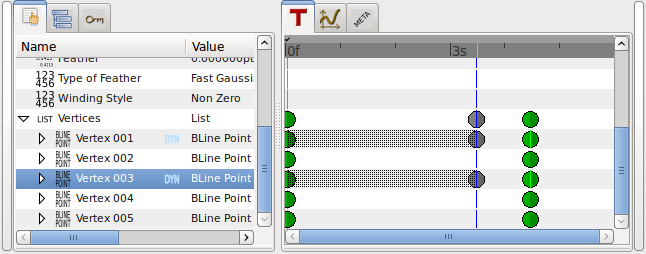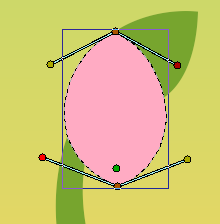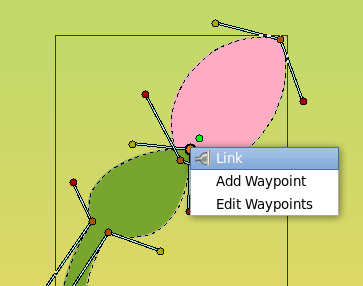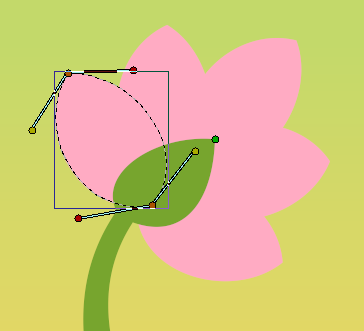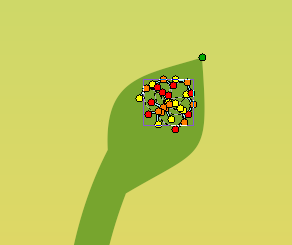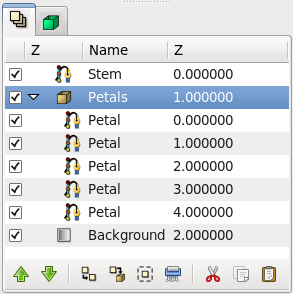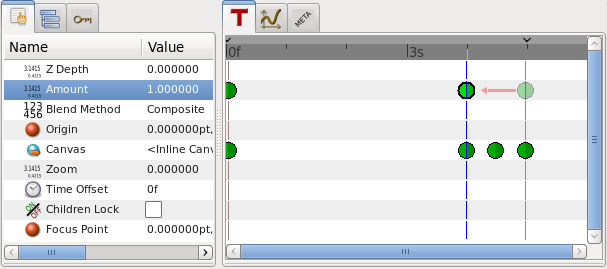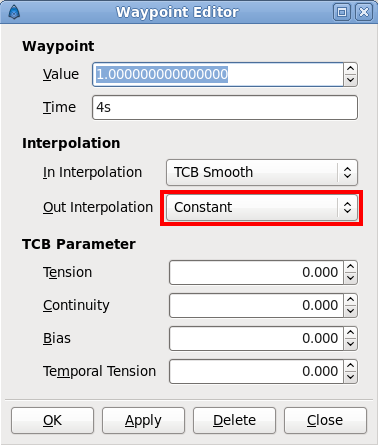Animazione Forme
| Line 86: | Line 86: | ||
[[Image:FlowerTutorial-9.png|center|frame]] | [[Image:FlowerTutorial-9.png|center|frame]] | ||
| − | + | Ora che c'è un collegamento tra il petalo e la cima dello stelo, quando la cima dello stelo muove, il petalo seguirà il movimento. (E se il manipolatore verde del petalo muove, la cima dello stelo muove con lui, ma non lo vogliamo fare ora.) | |
| − | + | Nel Panello Piani, seleziona il piano del petalo appena creato e duplicalo (con il terzo pulsante, in cima al pannello). Sulla tela, premi {{Shortcut|Ctrl|A}} per selezionare tuti i vertici del petalo selezionato, e spostali un pò, sì che non siano più sovrapposti. (Non muovere il manipolatore verde, solo quelli arancio). Ripeti il processo più volte, per ottenere qualcosa di simile a quanto in figura. | |
[[Image:FlowerTutorial-10.png|center|frame]] | [[Image:FlowerTutorial-10.png|center|frame]] | ||
Revision as of 11:19, 15 December 2010
|
Warning! This page contains outdated information. The release of Synfig Studio 0.64.0 introduced new terminology and this translated page needs to be updated according to original English text. You can help updating this page - see instructions here. Thank you! |
Impostazioni Base
In questa lezione impareremo come generare una semplice animazione di un fiore che cresce, usando le BLinee.
Avvia Synfig Studio — verrà aperta una nuova animazione. Se Synfig Studio è già apvviato, seleziona "File → Nuovo" nella casella strumenti.Come prima cosa generiamo un gradiente come sfondo. Clicca nella casella strumenti per selezionare il colore di riempimento desiderato. Puoi anche modificare il gradiente cliccando la linea del gradiente nella casella strumenti.
Seleziona lo Strumento Gradiente e trascina verticalmente sulla tela per riempire con il gradiente.
Adesso, seleziona lo Strumento BLinea e, nel Pannello Strumento Opzioni, assicurarsi che solo "Crea Regione BLinea" sia spuntato. Nella Casella Strumenti, imposta il colore di riempimento a verde. Disegna una specie di triangolo con lo strumento BLinea. Per chiudere la BLinea dopo aver disegnato i 3 vertici, clicca col destro sul primo vertice e scegli "Cicla BLinea".
Ora che la traccia della forma è chiusa, puoi generare la vera e propria forma selezionando un'altro strumento o premendo il pulsante con l'icona degli ingranaggi in basso nel Pannello Opzioni Strumenti.
Questa sarà la base del gambo. Puoi tarare i manipolatori delle tangenti (punti rossi) un pò per arrotondare leggermente il triangolo. Con lo Strumento Trasforma, clicca col destro su ogni vertice e seleziona "Separa Tangenti", so the tangent handles of each vertex can be moved separately. Con questo abbiamo terminato con le impostazioni base.
Animazione dello stelo
Nel Menu Tela, seleziona "Edita → Proprietà". Vai all'etichetta Tempo, imposta il "Tempo finale" a "6s" e clicca il pulsante OK.
Clicca all'inizio della linea temporale ("0f"), poi, sul Pannello Fotogrammi Chiave (quella con l'icona della chiave) clicca il pulsante con l'icona "+" (aggiungi un fotogramma chiave). Fotogrammi Chiave ti permette di impostare la scena; ad esempio su un fotogramma chiave, ogni elemento della scena memorizzerà le sue proprietà. Clicca sulla linea temporale, a "4.5s". Premi il cerchio verde in basso a destra rispetto alla tela (o l'icona che trovi in quella posizione, a seconda del tema di icone da te impostato) commuta in Modalità Edita Animazione (il cerchio ora è rosso).
Con lo Strumento Trasforma, seleziona gemma verde, e muovi il vertice superiore in alto per formare lo stelo. Puoi modificare i manipolatori del vertice per piegare un pò la forma, se vuoi.
Restando sui "4.5s", clicca col destro sul bordo del gambo, verso la punta, e scegli "Inserisci voce (intelligentet)". Ripetilo sull'altro lato del gambo. Clicca col destro sui nuovi punti e sciegli "Separa Tangenti". Quindi cerca di dargli una forma come quella dell'immagine, per creare il bocciolo.
Ora se clicchi su "2s" (ad esempio), vedrai che la forma del bocciolo è giusto visibile, anche se il germoglio è piuttosto piccolo e i manipolatori sono invisibili.
Diciamo di voler vedere il bocciolo, giusto visibile solo a 3.5s, e pienamente a 4.5s.
Clicchiamo su "3.5s" nella linea temporale. Ora guarda ai "Parametri" e al pannello "Línea Temporale" in basso. Vedrai che a ogni parametro nel Pannello Parametri corrisponde una lineanel Pannello Linea Temporale. L'ultimo parametro è la lista dei vertici. Clicca sulla piccola freccia a sinistra per aprire la lista. dovresti vedere qualcosa stile...:
Ogni grande punto verde (o interpolazione) inteso come valore preimpostato (qui le posizioni dei vertici sono state registrate a 0f come fotogramma chiave, e a 4s quando abbiamo spostato i vertici o i loro manipolatori). I due vertici aggiunti per disegnare la gemma sono impostati a "DYN" (dinamico). Clicca col destro su di essi nella lista parametri, e seleziona "Marca Punto Attivo come Off" [Disattivo].
Il pannello dovrebbe ora presentarsi come sotto, la fascia in grigio è la parte in cui i vertici della gemma non hanno alcun effetto sullo stelo.
Per esempio, se clicchi su "2s" o anche "3s" ora, la forma della gemma non è visibile. inizia a vedersi un pò solo dopo i 3.5s.
Tuttavia, la forma dello stelo potrebbe non essere un gran che durante la crescita tra 0 e 4s. Accertati di essere ancora in Modalità Editazione Animazione, e regola la forma nei vari momenti, per renderlo come ti piace.
L'animazione dello stelo è terminata, ma mancano ancora i petali. Per vedere un'anteprima dell'animazione, vai su "File → Anteprima", conferma, attendi la generazione anteprima, e guarda l'esito.
|
Nota Le anteprime sono spesso sgranate o sfocate, ma la renderizzazione finale risulterà nitida. Si possono ottenere anteprime con maggior livello qualitativo usando valori superiori di 'Ingrandimento' e 'Fotogrammi al secondo' nella finestra di dialogo dell'anteprima.
|
Aggiunta dei petali
Ora lascia la "Modalità Editazione Animazione" cliccando sul cerchio rosso in basso a destra dalla tela.
Cambia il colore di riempimento a rosa, e disegna un petalo con lo Strumento BLinea. Noterai che il manipolatore verde che facilita i movimenti di una forma è al centro della tela. Seleziona tutti i vertici del petalo con CtrlA e trascinali verso il manipolatore verde (con lo Strumento Trasforma), come mostrato.
Trascina quindi il manipolatore verde molto vicino alla cima della gemma. Premi nuovamente CtrlA per selezionare tutti i vertci del petalo aggiustalo usando lo Strumento Ruota. Inoltre, nel Pannello Piani seleziona il piano del petalo e ponilo sotto il piano dello stelo. Clicca sul petalo per selezionarlo, e con CTRL premuto clicca sullo stelo per selezionare entrambe gli oggetti.
Ora clicca sul vertice in cima allo stelo e col CTRL premuto clicca sul manipolatore verde del petalo (entrambe dovrebbero apparire con un colore più chiaro, giacché selezionati). Clicca quindi col destro sul vertice superiore dello stelo, e seleziona "Collega". Il petalo si muoverà seguendo la traiettoria del manipolatore del vertice dello stelo.
Ora che c'è un collegamento tra il petalo e la cima dello stelo, quando la cima dello stelo muove, il petalo seguirà il movimento. (E se il manipolatore verde del petalo muove, la cima dello stelo muove con lui, ma non lo vogliamo fare ora.)
Nel Panello Piani, seleziona il piano del petalo appena creato e duplicalo (con il terzo pulsante, in cima al pannello). Sulla tela, premi CtrlA per selezionare tuti i vertici del petalo selezionato, e spostali un pò, sì che non siano più sovrapposti. (Non muovere il manipolatore verde, solo quelli arancio). Ripeti il processo più volte, per ottenere qualcosa di simile a quanto in figura.
Note that the duplicated petals are also linked to the stem. If you go back to the first keyframe, you'll see that the petals are visible. We don't want that. We want the petals to appear and bloom almost at the end of the growth.
Hiding the petals
Let's say we want the petals to appear a little after 4 seconds in the animation, and be full size at 5 seconds, instead of being visible and full size all the time.
Switch to "Animate Editing Mode" again by clicking on the green circle at the bottom right of the canvas. But if we will go to "4s" and modify them, then they also change at "5s". Because the shape/position of the petals is not fixated at this moment of time by any waypoints or keyframes. That means that we need a keyframe at "5s". On the timetrack, click to place the cursor at 5 seconds. On the Keyframes Panel, click on "+" to add a new keyframe.
Now click on "4s", and on the Layers Panel, select all the petals layers (with ctrl+click), then press CtrlA to select all the petals vertices. Scale them down with the Scale Tool, and move them, so they are hidden by the stem, as shown.
From 4s to 5s, the petals will now appear and bloom. But notice that we have a keyframe at 0s which also remembers petals shape. That makes the problem — the petals are still visible from the first keyframe to the 4s keyframe. We could either an make petals tiny and hidden tweaking their size on every frame from 0s to 4s, or we could make them invisible on this interval.
Let's choose the second solution. To make things easier, we are going to encapsulate the petal layers into a Inline Canvas. With all the petal layers selected, right-click on them on the Layers Panel and select "Encapsulate". You can rename the layers to make things more understandable.
Select the "Petals" inline canvas and jump to the first keyframe. In the Param tabs, set the "Amount" value to "0". The petals are now invisible on that keyframe. Note that two waypoints were added in front of the "Amount" parameter, one at 0s and the other at 5s. Drag the 5s waypoint to 4s, so that the opacity of the petals will be 1 at 4s.
There is still one problem left: from 0s to 4s, the opacity of the petals slowly increases, making the petals visible when they shouldn't. To solve this, we will change the Amount interpolation method. Right click on the Amount waypoint at 0f, and select "Edit". A new dialog will appear, in which you can choose the In and Out interpolation. Set the Out Interpolation to "Constant".
|
Tip You can also change waypoint Out interpolation by right-clicking on it and selecting "Out → Constant".
|
This means that after that waypoint, the Amount value will remain constant, until another waypoint is encountered. So from 0f to 4s the Amount value will be equal to 0, and at 4s it will suddenly changed to 1, and make the petals visible, as expected. Alternatively, we could have achieved the same effect by setting the In Interpolation of the waypoint at 4s to "Constant".
Notice how (half of) the waypoint changes from a green circle (meaning smooth animation of the amount parameter) to a red step (meaning that the amount parameter is suddenly stepped).
Now you're done. The stem grows for 4.5 seconds and then stays still the last 1.5 second. The petals are hidden until 4 seconds, and then grow quickly between 4 and 5 seconds, and stay still the last 1 second too.
Click on "File → Render" to render your animation. Select any format you want, and ensure that "Use current frame" option is unchecked (otherwise, one frame only will be rendered).
